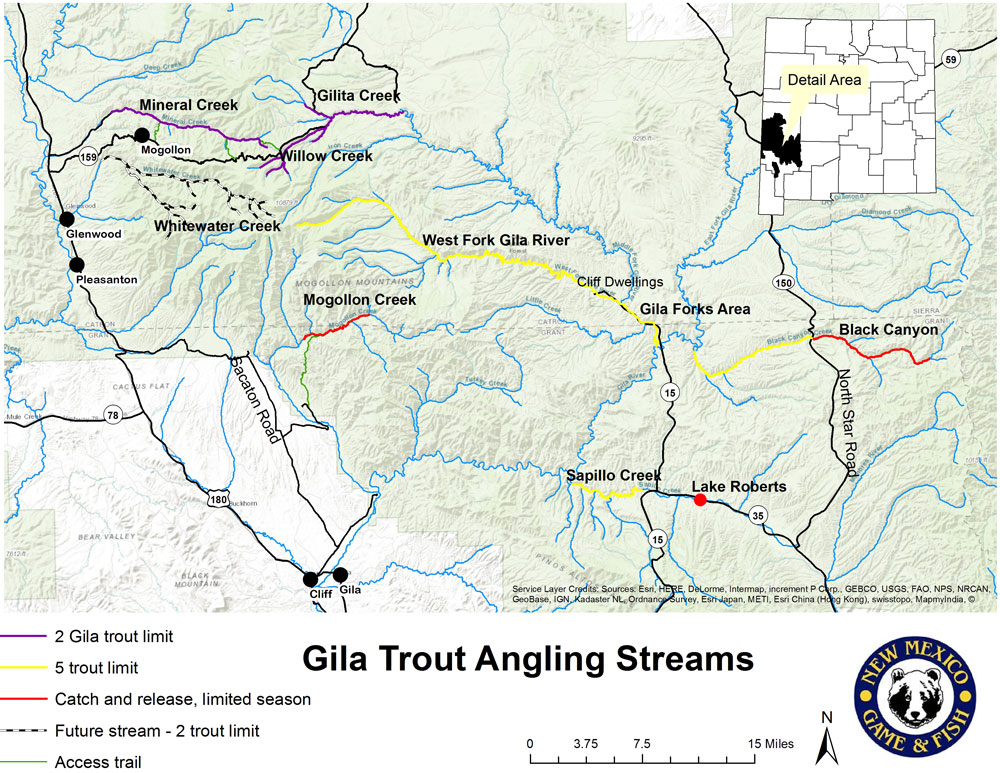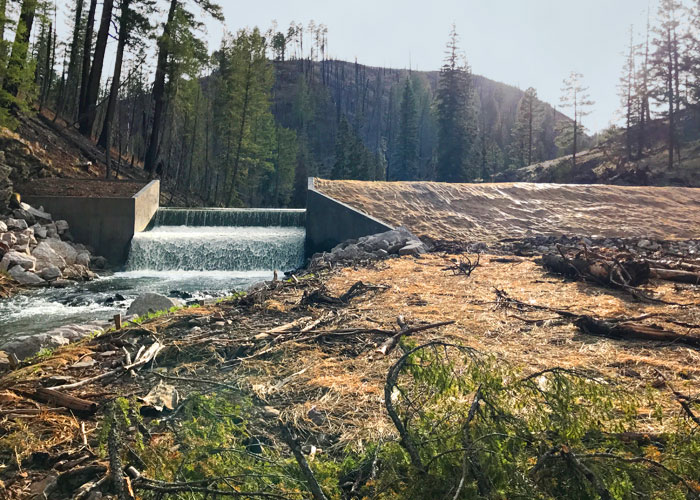Gila Trout Recovery & Angling
About
Gila Trout
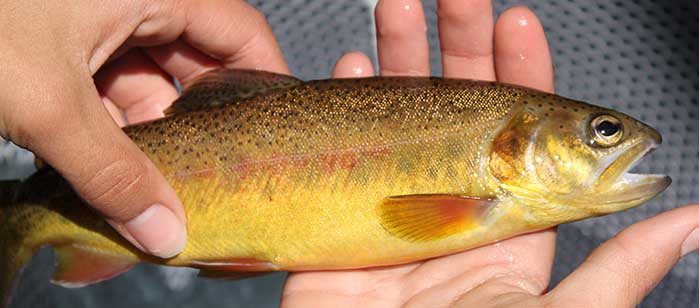
Gila trout (photo by Craig Springer)
Gila trout have been described as “taking their colors from the New Mexican sunset”, an apt description. Their iridescent gold sides blend to a darker shade of copper on the gill covers. Small, profuse spots cover the upper half of the body and a faint, salmon-pink band is present on adults, particularly during spawning season. A yellow cutthroat mark is present on most larger fish and parr marks are commonly found on adults. Because Gila trout are often found in small streams, they rarely grow larger than 12 inches.
Gila trout typically spawn in early spring, when water temperatures are rising. They sexually mature by age 3 and live between 4 and 6 years. Gila trout are capable of hybridizing with rainbow trout which has greatly reduced the range of pure Gila trout.
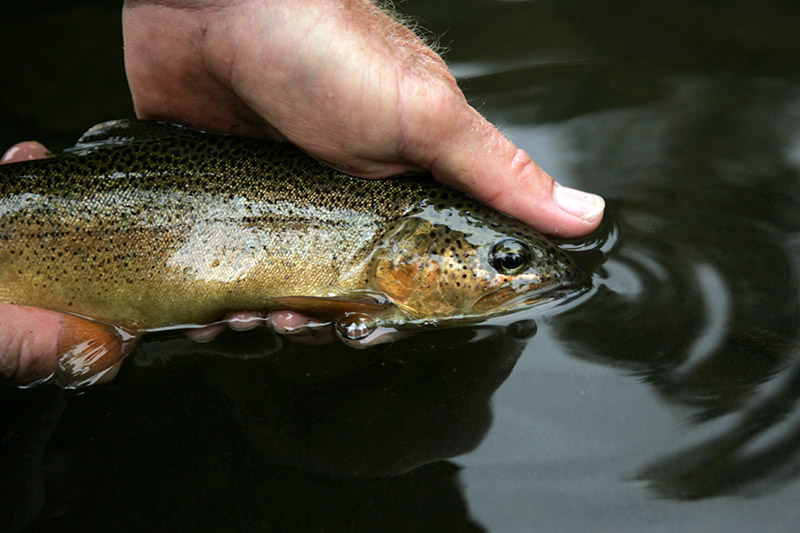
Photo by G. McReynolds
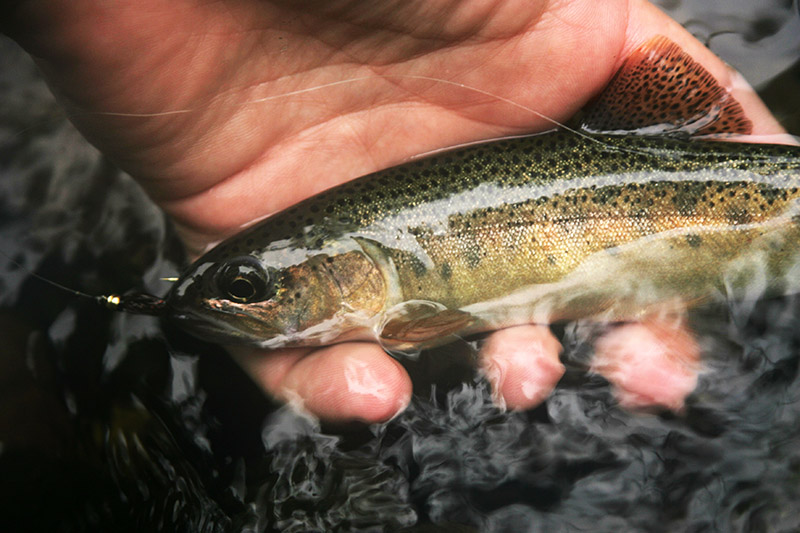
Photo by G. McReynolds
Where are they found?
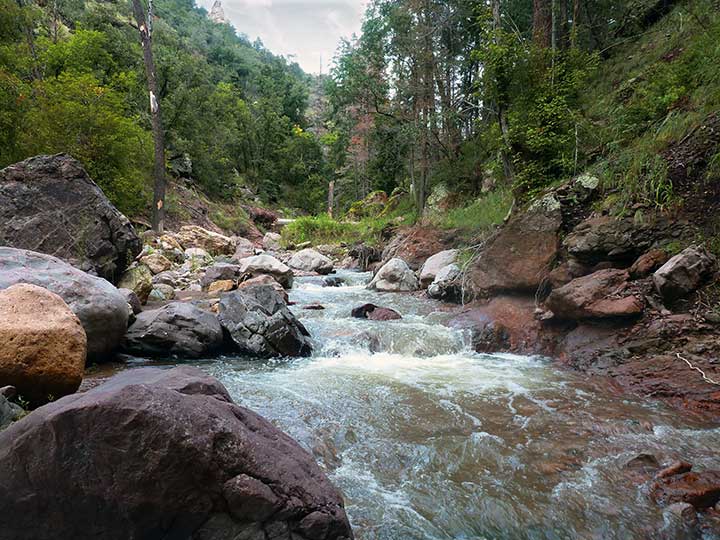
Trout habitat in Mineral Creek, a tributary to the San Francisco River in Catron County, NM. (photo NMDGF)
The Gila Wilderness was created in June 1924 at the urging of the conservation pioneer Aldo Leopold and was the world’s first designated wilderness. As part of congressionally designated wilderness, there are no roads and the only travel permitted is by foot or horseback. Logging is not allowed nor any commercial use except livestock grazing. Hunting and fishing activities, however, are open to everyone under laws set by the New Mexico State Game Commission.
History
Gila trout are relatives of the Pacific salmon, originally making their way up into the mountains of the Southwest by migrating from the Gulf of California. As the climate and landscape changed, they could no longer move between the mountains and the ocean. Their range was reduced to the mountain streams of the Gila, San Francisco, and Verde River Basins in New Mexico, where they evolved to survive harsh conditions. By the late 1800’s overfishing, land use practices that led to habitat deterioration and stocking of nonnative trout, which compete with, predate upon, and sometimes interbreed with Gila trout, began to take its toll on Gila trout. In the 1950’s, when Gila trout was officially described as a species, they remained in only five streams.
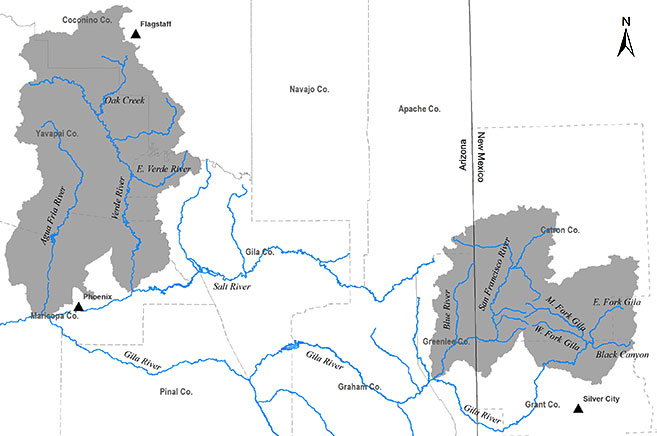
Historical distribution of Gila trout
Conservation
Gila trout was the first western North American fish to be actively managed to conserve it. Conservation efforts began as early as the 1920s when the New Mexico Department of Game and Fish established the Jenks Cabin Hatchery in the heart of the Gila and began raising Gila trout. Around the same time, the agency established a policy of not stocking nonnative salmonids into streams known to support Gila trout. In the 1950s, the first Gila trout streams were closed to angling. Despite these efforts, Gila trout was listed as endangered under the Endangered Species Act of 1973 and the New Mexico Wildlife Conservation Act of 1974.
Today, Gila trout conservation is guided by the Gila Trout Recovery Plan (2003) and the Gila Trout Recovery Team, which is composed of professionals from NM Department of Game and Fish, US Forest Service, US Fish and Wildlife Service, the University of New Mexico, and the Arizona Game and Fish Department. The agencies continue a program of stream restoration – removing nonnative species, constructing barriers to prevent nonnatives from reinvading, and returning Gila trout – and pure Gila trout currently inhabit eleven streams in New Mexico.
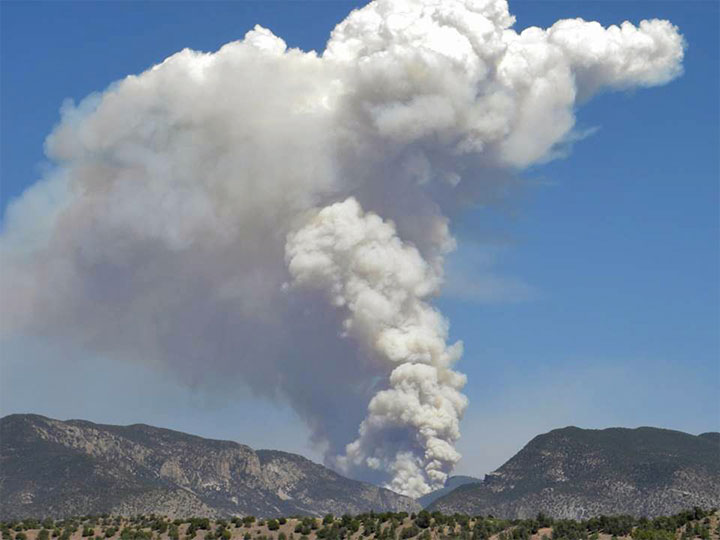
The Whitewater Baldy Fire burned through almost 300,000 acres of the Gila National Forest in spring 2012. (photo USFS-Gila National Forest)
In addition to competition and hybridization with nonnative trout, wildfire is a major threat to the survival of Gila trout. Toxic ash flows following high-intensity wildfires often result in fish kills. Multiple wildfires have had the direct and immediate effect of eliminating fish from a stream and because of this, Gila trout are often evacuated from streams that are threatened by wildfires. The largest fire in New Mexico history, the nearly 300,000 acre Whitewater Baldy Fire, burned through nearly half of the existing Gila trout streams in 2012 and fish were eliminated from six of the eight streams that were within the burned area. Gila trout were evacuated from three streams following the fire.
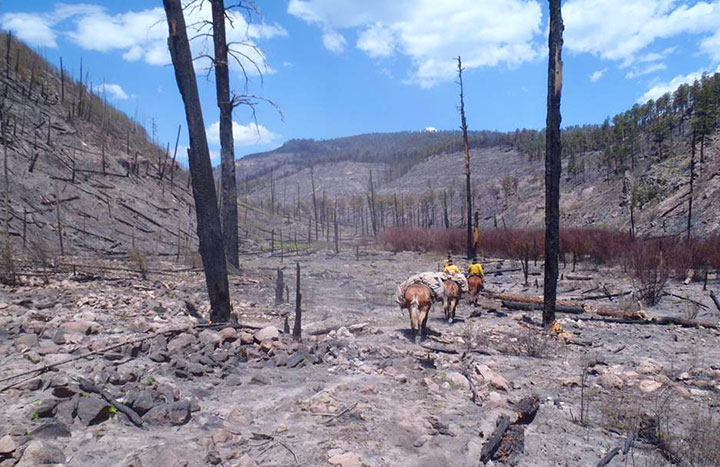
Riding through the upper West Fork Gila River Drainage to rescue and evacuate Gila trout from Whiskey Creek after the 2012 Whitewater Baldy Fire. (photo USFWS)
Current conservation efforts (see Current Projects tab on this page) consist of returning Gila trout to the streams affected by the wildfire, continuing to establish them in new streams, and developing opportunities to fish for this rare trout (see Where to Fish tab on this page).
Where to Fish (Update 4-23-20)
Gila Trout Angling Streams
Content updated 04-23-2020.
Mogollon Creek from waterfall to Trail Canyon: Open July 1 – October 31, catch and release, single hook/artificial lure. Surveys conducted upstream of the area open to fishing in spring 2013 indicate a good wild Gila trout population remains in Mogollon Creek.
Willow Creek: 2 Gila trout limit, unlimited brown trout. Most recently, 3,100 (4.5”) Gila trout were stocked in November 2018 and 800 (4.3”) Gila Trout in December 2019. There is a naturally reproducing population of Gila trout in Willow Creek and the best fishing can be found in the headwaters area upstream of the private property.
Gilita Creek: 2 Gila trout limit, unlimited brown trout. Most recently, 1,900 (4”) Gila Trout were stocked in November 2018 and 140 (12.5”) Gila Trout in October 2019.
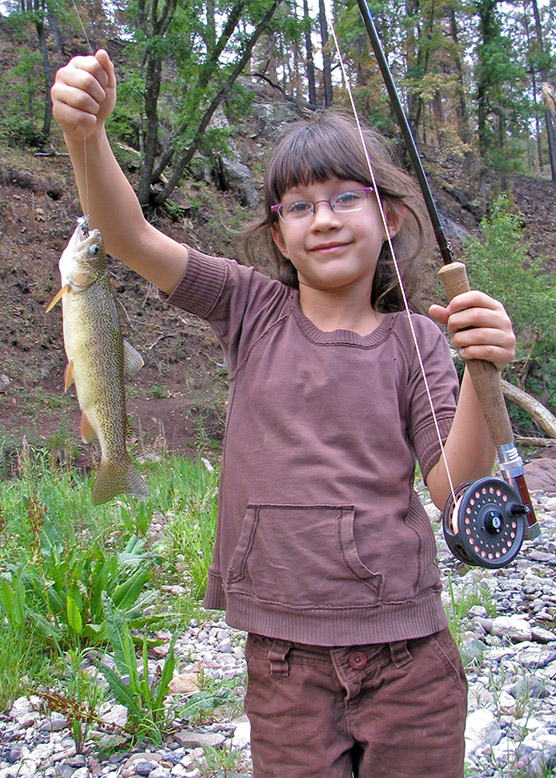
Willow Springer hefts a Gila trout in New Mexico’s Black Canyon (photo Graig Springer)
Black Canyon above fish barrier: Open July 1 – October 31, catch and release, single hook/artificial lure. Trout populations were severely impacted by the 2013 Silver Fire and subsequent flooding, but habitat and the trout population is beginning to rebound. Recent surveys (summer 2018) show healthy and abundant populations of Gila Trout with several large adults persisting despite the low water conditions in 2018. Over 5,000 Gila trout (5”) were stocked throughout Black Canyon in September 2017.
Black Canyon below fish barrier: 5 trout limit. Recent surveys (summer 2018) indicate Gila Trout are present in Black Canyon below the fish barrier. Stocked with 1,000 (4.5”) Gila Trout in November 2018.
West Fork Gila River from headwaters to Ring Canyon: 5 trout limit. Surveys indicate a healthy population of wild Gila, rainbow, and brown trout are found in this section of the West Fork Gila River.
Gila River Forks Area: 5 trout limit. The Gila River Forks Area is stocked annually with Gila Trout from November through April. Most recently it was stocked with 200 (10”) Gila Trout in April 2019, 1,800 (8.5”) Gila Trout in June 2019, and 2,500 (4.8”) Gila Trout in December 2019.
Sapillo Creek: 5 trout limit. Sapillo Creek is stocked with Gila Trout from November through April. Stocked with 1,400 Gila Trout (6”) in December 2017, 900 (7”) Gila Trout in February 2018 and 400 (8”) Gila Trout in Nov.2018.
Mineral Creek: 2 trout limit. Mineral Creek is a newer Gila Trout stream and was stocked for a 3 year period in 2016-2018. Most recently it was stocked with 2,000 (5”) Gila Trout in October of 2018.
Lake Roberts: 5 trout limit. Stocked with 3,000 (4”) Gila Trout in November 2018, 1,200 (11”) Gila Trout in September 2019 and 980 (13”) Gila Trout in October 2019.
Gwynn Tank: 5 trout limit. Stocked in 2018 with Gila Trout for the first time in over 70 years! Most recently stocked with 150 10” Gila Trout in April 2019 and 135 (13”) Gila Trout in October 2019.
Whitewater Creek (Catwalk section): 2 trout limit. The newest Gila trout steam open to fishing. This stream is expected to become one of the best Gila trout fisheries in the state and provides easy access to Gila trout angling. Recently stocked with 175 (14”) Gila Trout in January 2019, 210 (18”) Gila Trout in May 2019, and 1,200 (5”) Gila Trout in December 2019.
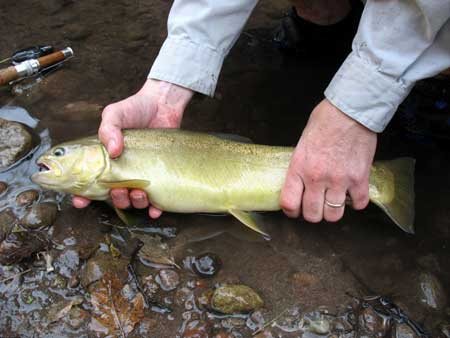
Hatchery Gila Trout – Caught in West Fork Gila River 2008 (Photo by R. C. Helbock)
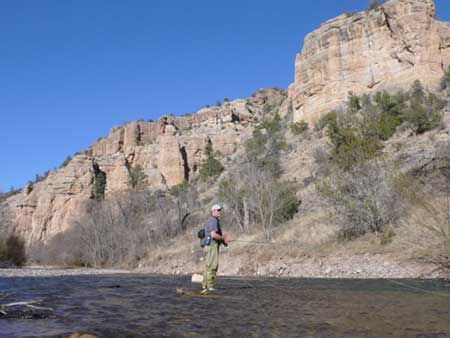
Fishing the Gila Forks 2008 (Photo by G. McReynolds)
Current Projects
The Department is currently working on multiple Gila trout recovery projects as well as projects to enhance Gila trout angling opportunities. These include:
- establishing a new population of Gila trout in Mineral Creek,
- restoration of Gila trout to Whitewater Creek,
- completion (summer 2016) of a fish barrier on Willow Creek to protect the new Gila trout population in the stream,
- beginning to grow out Gila trout at the Glenwood State Fish Hatchery.

